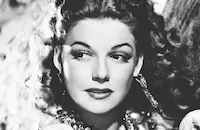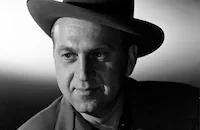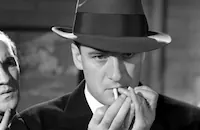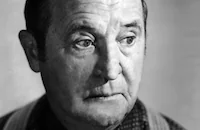Navy Blues

Brief Synopsis
Cast & Crew
Lloyd Bacon
Ann Sheridan
Jack Oakie
Martha Raye
Jack Haley
Herbert Anderson
Film Details
Technical Specs

Synopsis
Lilibelle Bolton and Margie Jordan are two show girls working in Honolulu. A Navy ship carrying Cake O'Hare and Lilibelle's ex-husband, Powerhouse Bolton, docks in port and is met by Lilibelle, who is in search of her alimony. Powerhouse is surprised to see Lilibelle, as she was in San Diego when his ship set sail. In order to get rid of her, Powerhouse and Cake pretend that she was asking them questions about the ship and have her arrested as a spy. The sailors' plan to have a wild shore leave is hampered by their lack of funds and they unsuccessfully beg their shipmates for help. When Cake and Powerhouse learn that expert gunner Homer Matthews is transferring to their ship, however, they believe that their problems are solved. Because no one else knows about Homer's transfer, they plan to place bets that their ship will win the upcoming gunnery contest. They ask Lilibelle and Margie for front money, and when they are refused, talk petty officer Buttons Johnson into putting up the money. All the other sailors are eager to take their bet, and Cake and Powerhouse envision great riches until they learn that Homer's service will be up before the gunnery contest.
Margie suggests that they get Homer to re-enlist, but Cake and Powerhouse are unable to shake Homer's determination to return to his family farm. Finally Margie points out that most men join the Navy hoping to meet women and agrees to play up to the shy sailor. Together Margie and Homer attend a livestock exhibition and go rowing, water skiing and horseback riding, but nothing seems to work. Then Lilibelle discovers that Homer plans to marry Margie and take her back to the farm with him. To stop this, Cake and Powerhouse tell Homer that Margie has only been nice to him to make him re-enlist. Paradoxically, this information causes Homer to re-join the Navy because he cannot bear to go home without Margie. When the gunnery contest takes place, however, Homer is too lovesick to shoot. Cake tries to persuade him that Margie cares for him, but Homer is not convinced until Margie flies over the ship in an airplane and, using a hog call, demonstrates that she really loves him. Homer wins the gunnery contest and Lilibelle finally collects her alimony.

Director

Lloyd Bacon
Cast

Ann Sheridan

Jack Oakie

Martha Raye

Jack Haley

Herbert Anderson

Jack Carson

Jackie C. Gleason

William T. Orr

Richard Lane

John Ridgely

Katharine Aldridge
Georgia Carroll

Marguerite Chapman
Peggy Diggins

Lorraine Gettman
Claire James

Howard Da Silva
Dick Wessel
Victor Zimmerman
Frank Wilcox

Emmett Vogan

Charles Drake
William Forrest

Hardie Albright
William Justice
Ray Cooke
Dewolfe Hopper
Nick Lukats
Renny Mcevoy

George O'hanlon
Arthur Gardner
Will Morgan
Garland Smith

Byron Barr
Murray Alper
Fred Graham
Lane Allan
Ralph Byrd

Elliott Sullivan
William Newell
Don Rowan
Gaylord Pendleton
Pat Mcveigh

Walter Sande
Tom Dugan
Ed Gargan

Frank Orth
G. Pat Collins
Selmer Jackson
Harry Strang
Ed Stanley
Jean Ames

Maris Wrixon

Lucia Carroll
Crew
Eddie Blatt
Rudi Fehr
Seymour Felix
Leo F. Forbstein
Tony Gaudio
J. J. Giblon
Carl Guthrie
Robert Haas
Ray Heindorf
Stuart Higgs
Arthur T. Horman
Arthur T. Horman
James Wong Howe
H. F. Koenekamp
Richard Macaulay
Dick Mayberry
Johnny Mercer
Sam Perrin
Sol Polito
C. A. Riggs
Jack Saper
Arthur Schwartz
Howard Shoup
Jerry Wald
Jerry Wald
Perc Westmore

Film Details
Technical Specs

Articles
Navy Blues
Filmed at the San Diego naval base during a quick shoot from April to June 1941, the film was budgeted at $1.2 million, a fairly high amount for such a picture. The answer most likely lies in star Jack Oakie's salary, having been nominated for an Academy Award the previous year as Best Supporting Actor for his role as Napaloni in Charlie Chaplin's The Great Dictator (1940). Navy Blues, a fluff piece about the mishaps of two Navy men, also co-starred Jack Haley (best known as the Tin Man in The Wizard of Oz [1939]), and the up and coming Jack Carson. The female roles were taken by Ann Sheridan and Martha Raye. In a smaller role was Gleason as a sailor named Tubby. The six women who appeared as the Navy Blues Sextet in the film were actually chosen by servicemen who were asked to select the six most beautiful women out of 150. Those chosen were Georgia Carroll, future star Alexis Smith, Loraine Gettman (later known as Leslie Brooks), Kay Aldridge, Marguerite Chapman and Peggy Diggins. Smith was later given a role in Dive Bomber (1941) and was replaced by Claire James.
Although Gleason was a newcomer, he found acceptance and life-long friendship from the other Jacks, despite their star status. They became drinking buddies known as "The Four Jacks". Gleason remembered in a 1985 article, "I never expected anything from Hollywood. I had no idea of becoming a big star, having a big picture career. I was a kid, I was having a lot of fun, and they were paying me $250 a week in the Depression! Not bad. [Navy Blues] had Jack Oakie, Jack Haley, Jack Carson, me, and Ann Sheridan, some of the worst drinkers in the history of show business. Now, across the street from Warners was a joint called My Blue Heaven. And every day when they wrapped, there was a stampede across the street. I mean a stampede! I mean, these were drinkers."
Gleason considered Jack Oakie "my personal Knute Rockne" as Oakie was supportive of the younger man who had long admired him; and more than one critic accused Gleason of stealing parts of Oakie's shtick most notably his double-take, for which he was famous. Another of the Jacks, Jack Haley, would become Gleason's best friend in Hollywood, despite their nineteen-year age difference. Haley's wife, Flo, remembered Gleason's reaction to seeing himself in the film. "My husband didn't particularly care for Navy Blues and wouldn't go to the big Hollywood preview. Gleason said, 'Well, I never made one of these before and I am going,' so my husband said 'Call me and tell me how it was.' When Jackie rang up, he said, 'Never mind how it was. I can guess. How were you?' And Gleason said to my Jack, 'I look like a guy standing on the street corner watching it being made.'"
Allen Wolf, in his book, The Hollywood Musical Goes to War makes the claim that Navy Blues and You're in the Army Now (1941), both Warner Brothers, are essentially the same film. "Both attempted to capitalize on the new interest in war-theme films. They were actually the same musical, only the cut and color of the uniforms were different. Both concerned two hapless dupes drafted into the armed forces, and the troubles they caused their superior officers. Although ostensibly comic in form, each film displayed a few moments of serious intent. In Navy Blues, Ann Sheridan explains to a naval gunner that it is unpatriotic for him to give up the navy in order to return to his farm in Iowa. You're in the Army Now also allows [Jimmy] Durante and [Phil] Silvers to explain the importance of the newly enacted selective service laws in song. [...] They were the last films at Warners to make light of the armed forces."
Bosley Crowther was less than impressed in his New York Times review of the film when it was released on September 13, 1941, writing, "For a picture about the Navy and sea-dogs, there is an uncommon amount of horseplay in the Warners' Navy Blues, which was warped into the Strand yesterday. But that's about what you would expect from a musical monkeyshine which harbors Jack Oakie, Jack Haley, Martha Raye and Ann Sheridan in its cast and which gets along without benefit of any strong assistance from its script. So you who are not averse to a lot of broad and unrestrained mugging-to a generous display of the Messrs. Oakie and Haley working harder for laughs than a bum vaudeville team in Omaha-and for those who like your musical shows noisy, this one should be all right."
While Navy Blues didn't particularly help Gleason's career, it did get him out of a financial jam. In the days before credit cards, Gleason found himself stuck in Arizona without money for a train ticket back to New York. Since no one would take personal checks from out of town, Gleason tried several stores before he was able to convince a hardware store owner to cash it. The solution: he took the owner to see Navy Blues, which was playing in town, and was able to prove to him that the check would be good.
Director: Lloyd Bacon
Screenplay: Richard Macaulay, Sam Perrin, Jerry Wald; Arthur T. Horman (story and screenplay)
Cinematography: Tony Gaudio; James Wong Howe, Sol Polito (dance sequences)
Art Direction: Robert Haas
Music: Heinz Roemheld (music cues, uncredited)
Film Editing: Rudi Fehr
Cast: Ann Sheridan (Marge 'Margie' Jordan), Jack Oakie (Cake O'Hara), Martha Raye (Lilibelle Bolton), Jack Haley (Powerhouse Bolton), Herbert Anderson (Homer Matthews), Jack Carson ('Buttons' Johnson), Jackie C. Gleason (Tubby), William T. Orr (Mac), Richard Lane ('Rocky' Anderson), John Ridgely (Jersey), Navy Blues Sextette (Musical Sextette).
BW-108m.
by Lorraine LoBianco
SOURCES:
Take it from the Big Mouth: The Life of Martha Raye by Jean Maddern Pitrone
New York Magazine article, Gleason's Second Honey: Still the Greatest by Pete Hamill, September 23, 1985
The Great Clowns of American Television by Karin Adir
The Great One by William A. Henry III
The New York Times film review by Bosley Crowther, September 13, 1941
The Internet Movie Database

Navy Blues
Quotes
Trivia
The Navy Blues Sextet were the winners of a contest in which U.S. soldiers were asked to pick the 6 most beautiful women from a field of 150, many of whom were Warner Bros. contract actresses. The winners were Georgia Carroll, Alexis Smith, Loraine Gettman (Leslie Brooks), Kay Aldridge, Marguerite Chapman and Peggy Diggins. Alexis Smith was replaced by Claire James for this movie when Smith was assigned a role in Dive Bomber (1941).
Notes
According to a statement at the end of the credits, this picture was produced under the auspices of the motion picture committee cooperating for national defense. A January 15, 1941 news item in Los Angeles Examiner notes that Warner Bros. budgeted $1,200,000 for the film, that Sam Wood was to direct, that Eddie Albert was to co-star with Jack Haley and Jack Oakie and that Cole Porter was to write the songs. According to an March 11, 1941 Hollywood Reporter news item, Al Dubin was to collaborate with Arthur Schwartz on the songs. Other Hollywood Reporter news items add the following information about the production: Mark Hellinger was initially assigned as associate producer. The studio considered making the film in Technicolor. The Dudley Chambers Choral Group was to be included, but its participation in the final film has not been determined. A unit was sent to Honolulu to film hula dancers for scenes in the movie.
According to a press release dated April 16, 1941 included in the file on the film at the AMPAS Library, the Navy Blues Sextet was created when United States soldiers were asked to choose the six most beautiful women from a field of 150, many of whom were Warner Bros. contract players. A May 1, 1941 press release lists the winners as Georgia Carroll, Alexis Smith, Loraine Gettman, Kay Aldridge, Marguerite Chapman and Peggy Diggins. Hollywood Reporter notes that Claire James replaced Alexis Smith before filming when the latter was assigned to Dive Bomber, and an October 8, 1941 press release notes that Alice Talton replaced Claire James before the filming of You're in the Army Now. Navy Blues marked the motion picture debut of actor/comedian Jackie Gleason.















